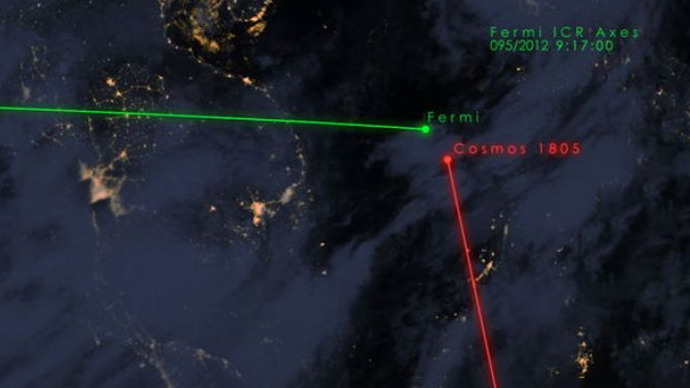Crowded orbit: Space junk nearly brings down NASA telescope

The Fermi Space Telescope’s fate was hanging by a hair, NASA has revealed, as it met an old inactive Soviet satellite last year.
The accident details of which has just been released goes back to April 2012, when NASA realized that the Fermi Telescope was set to brush past the Soviet Cosmos 1805 satellite. This satellite is a 1.5-ton piece of junk circling the orbit.
Had the two objects collided, the US$690 million US spacecraft would have been destroyed, as the clash would have released energy equivalent to two tons of explosives.
“These are objects of several tons each, as wide as a small airplane, traveling 20 times faster than a bullet. The Fermi mission would be over,” the statement on NASA’s official website quotes engineer Eric Stoneking, who controls Fermi’s orientation in the sky.
The Fermi mission first learned of the potential space collision threat on March 29, 2012. Primary calculations showed that the two space objects would miss each other by just more than 200 meters. But later it became clear that their orbits would cross through the same point in space within 30 milliseconds of one another.
Since the Russian space junk was travelling at a speed of 43,000kph, the Fermi mission engineers decided not to run a risk and corrected the orbit of the US spacecraft. The scientists fired Fermi's thrusters, which were specifically designed to move the satellite out of the way in such situations.
The two spacecraft successfully missed each other by almost 10km when they passed one another on April 3, 2012.
"The maneuver, which was performed by the spacecraft itself based on procedures we developed a long time ago, was very simple, just firing all thrusters for one second," Stoneking said, adding that "there was a lot of suspense and tension leading up to it, but once it was over, we just sighed with relief that it all went well."
Due to that maneuver, Fermi is still looking for dark matter and black holes. Launched in 2008, the spacecraft is expected to remain in orbit until 2018. While the 26-year-old Cosmos 1805 satellite is just another dead spacecraft still floating around in space.
Since the launch of the first satellite in 1957, space junk has been a growing threat to all spacecraft, as occasional collisions occur. NASA tracks 17,000 objects larger than 10cm across in orbit above the Earth daily. Only 10 per cent of those tracked objects are actually active satellites.












